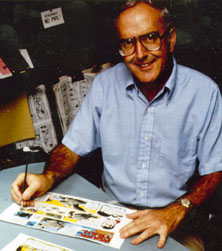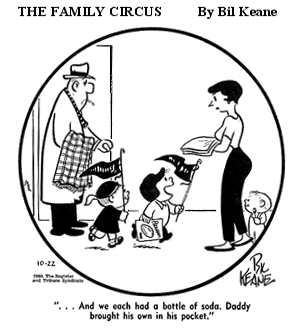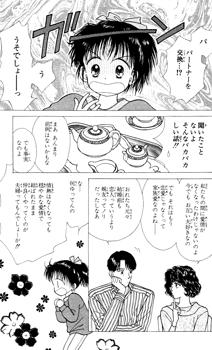A comic strip is a sequence of cartoons, arranged in interrelated panels to display brief humor or form a narrative, often serialized, with text in balloons and captions. Traditionally, throughout the 20th and into the 21st century, these have been published in newspapers and magazines, with daily horizontal strips printed in black-and-white in newspapers, while Sunday papers offered longer sequences in special color comics sections. With the advent of the internet, online comic strips began to appear as webcomics.

A cartoon is a type of visual art that is typically drawn, frequently animated, in an unrealistic or semi-realistic style. The specific meaning has evolved, but the modern usage usually refers to either: an image or series of images intended for satire, caricature, or humor; or a motion picture that relies on a sequence of illustrations for its animation. Someone who creates cartoons in the first sense is called a cartoonist, and in the second sense they are usually called an animator.

The Yellow Kid is an American comic-strip character that appeared from 1895 to 1898 in Joseph Pulitzer's New York World, and later William Randolph Hearst's New York Journal. Created and drawn by Richard F. Outcault in the comic strip Hogan's Alley, it was one of the first Sunday supplement comic strips in an American newspaper, although its graphical layout had already been thoroughly established in political and other, purely-for-entertainment cartoons. Outcault's use of word balloons in The Yellow Kid influenced the basic appearance and use of balloons in subsequent newspaper comic strips and comic books.

Comics are a medium used to express ideas with images, often combined with text or other visual information. It typically takes the form of a sequence of panels of images. Textual devices such as speech balloons, captions, and onomatopoeia can indicate dialogue, narration, sound effects, or other information. There is no consensus among theorists and historians on a definition of comics; some emphasize the combination of images and text, some sequentiality or other image relations, and others historical aspects such as mass reproduction or the use of recurring characters. Cartooning and other forms of illustration are the most common image-making means in comics; Photo comics is a form that uses photographic images. Common forms include comic strips, editorial and gag cartoons, and comic books. Since the late 20th century, bound volumes such as graphic novels, comic albums, and tankōbon have become increasingly common, along with webcomics as well as scientific/medical comics.

Addison Morton Walker was an American comic strip writer, best known for creating the newspaper comic strips Beetle Bailey in 1950 and Hi and Lois in 1954. He signed Addison to some of his strips.

A cartoonist is a visual artist who specializes in both drawing and writing cartoons or comics. Cartoonists differ from comics writers or comics illustrators/artists in that they produce both the literary and graphic components of the work as part of their practice.

The Family Circus is a syndicated comic strip created by cartoonist Bil Keane and, since Keane's death in 2011, is written, inked and rendered (colored) by his son Jeff Keane. The strip generally uses a single captioned panel with a round border, hence the original name of the series, which was changed following objections from the magazine Family Circle. The series debuted on February 29, 1960 and has been in continuous production ever since. According to publisher King Features Syndicate, it is the most widely syndicated cartoon panel in the world, appearing in 1,500 newspapers. Compilations of Family Circus comic strips have sold more than 13 million copies worldwide.

King Features Syndicate, Inc. is an American content distribution and animation studio, consumer product licensing and print syndication company owned by Hearst Communications that distributes about 150 comic strips, newspaper columns, editorial cartoons, puzzles, and games to nearly 5,000 newspapers worldwide. King Features Syndicate also produces intellectual properties, develops new content and franchises, like The Cuphead Show!, which it produced with Netflix, and licenses its classic characters and properties.

Speech balloons are a graphic convention used most commonly in comic books, comics, and cartoons to allow words to be understood as representing a character's speech or thoughts. A formal distinction is often made between the balloon that indicates speech and the one that indicates thoughts; the balloon that conveys thoughts is often referred to as a thought bubble or conversation cloud.
The comic strip switcheroo was conducted on April 1, 1997, in which several cartoonists, without the foreknowledge of their editors, worked on the other's comic strip for that date, in commemoration of April Fools' Day.
A gag cartoon is most often a single-panel cartoon, usually including a caption beneath the drawing. In some cases, dialogue may appear in speech balloons, following the common convention of comic strips. A pantomime cartoon carries no caption.

Japanese manga has developed its own visual language or iconography for expressing emotion and other internal character states. This drawing style has also migrated into anime, as many manga stories are adapted into television shows and films. While this article addresses styles from both types of output, the emphasis here is on the manga origins for these styles.

John Stanley was an American cartoonist and comic book writer, best known for writing Little Lulu comic book stories from 1945 to 1959. While mostly known for scripting, Stanley also drew many of his stories, including the earliest issues of Little Lulu and its Tubby spinoff series. His specialty was humorous stories, both with licensed characters and those of his own creation. His writing style has been described as employing "colorful, S. J. Perelman-ish language and a decidedly bizarre, macabre wit ", with storylines that "were cohesive and tightly constructed, with nary a loose thread in the plot". He has been compared to Carl Barks, and cartoonist Fred Hembeck has dubbed him "the most consistently funny cartoonist to work in the comic book medium". Captain Marvel co-creator C. C. Beck remarked, "The only comic books I ever read and enjoyed were Little Lulu and Donald Duck".

Grawlix or obscenicon is the use of typographical symbol to replace profanity. Mainly used in cartoons and comics, it is used to get around language restrictions or censorship in publishing. At signs (@), dollar signs ($), number signs (#), ampersands (&), percent signs (%), and asterisks (*) are oft-used symbols. The characters may resemble the letters they replace, such as "$" standing in for "S".
The history of comics has followed different paths in different parts of the world. It can be traced back to early precursors such as Trajan's Column, in Rome, Egyptian hieroglyphs and the Bayeux Tapestry.
"How to ReadNancy" is an essay by Mark Newgarden and Paul Karasik, originally published in The Best of Ernie Bushmiller's Nancy by Brian Walker. The piece examines the comic strip Nancy, focusing on Bushmiller's use of the comics language to deliver a gag. Finding correspondences to the minimalist architecture of Mies van der Rohe, the essay calls Nancy "a complex amalgam of formal rules laid out by [its] designer."

Comics journalism is a form of journalism that covers news or nonfiction events using the framework of comics, a combination of words and drawn images. Typically, sources are actual people featured in each story, and word balloons are actual quotes. The term "comics journalism" was coined by one of its most notable practitioners, Joe Sacco. Other terms for the practice include "graphic journalism," "comic strip journalism", "cartoon journalism", "cartoon reporting", "comics reportage", "journalistic comics", "sequential reportage," and "sketchbook reports".

Canadian comics refers to comics and cartooning by citizens of Canada or permanent residents of Canada regardless of residence. Canada has two official languages, and distinct comics cultures have developed in English and French Canada. The English tends to follow American trends, and the French, Franco-Belgian ones, with little crossover between the two cultures. Canadian comics run the gamut of comics forms, including editorial cartooning, comic strips, comic books, graphic novels, and webcomics, and are published in newspapers, magazines, books, and online. They have received attention in international comics communities and have received support from the federal and provincial governments, including grants from the Canada Council for the Arts. There are comics publishers throughout the country, as well as large small press, self-publishing, and minicomics communities.
Comics has developed specialized terminology. Several attempts have been made to formalize and define the terminology of comics by authors such as Will Eisner, Scott McCloud, R. C. Harvey and Dylan Horrocks. Much of the terminology in English is under dispute, so this page will list and describe the most common terms used in comics.

Harvey Kurtzman's Jungle Book is a graphic novel by American cartoonist Harvey Kurtzman, published in 1959. Kurtzman aimed it at an adult audience, in contrast to his earlier work for adolescents in periodicals such as Mad. The social satire in the book's four stories targets Peter Gunn-style private-detective shows, Westerns such as Gunsmoke, capitalist avarice in the publishing industry, Freudian pop psychology, and lynch-hungry yokels in the South. Kurtzman's character Goodman Beaver makes his first appearance in one of the stories.












